Related Research Articles

Begonia is a genus of perennial flowering plants in the family Begoniaceae. The genus contains more than 2,000 different plant species. The Begonias are native to moist subtropical and tropical climates. Some species are commonly grown indoors as ornamental houseplants in cooler climates. In cooler climates some species are cultivated outside in summertime for their bright colorful flowers, which have sepals but no petals.

Epacris impressa, also known as common heath, is a species of plant in the heath family Ericaceae. It is native to south-eastern Australia. French botanist Jacques Labillardière collected the species in 1793 and described it in 1805. Four forms have been identified, but no subspecies are recognised. Growing in heathland, shrubland or open forest, it is generally a small shrub around 0.5 to 1 m tall, with small stiff leaves. The red, pink or white tube-like flowers appear from late autumn to early spring. Honeyeater birds, particularly the eastern spinebill, feed upon the nectar of the flowers. It regenerates after bushfire by seed or by resprouting.
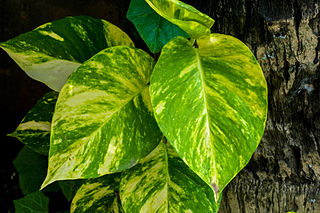
Epipremnum aureum is a species in the arum family Araceae, native to Mo'orea in the Society Islands of French Polynesia. The species is a popular houseplant in temperate regions but has also become naturalised in tropical and sub-tropical forests worldwide, including northern South Africa, Australia, Southeast Asia, South Asia, the Pacific Islands and the West Indies, where it has caused severe ecological damage in some cases.
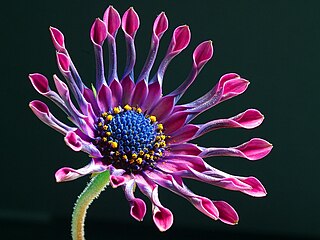
A cultivar is a kind of cultivated plant that people have selected for desired traits and which retains those traits when propagated. Methods used to propagate cultivars include division, root and stem cuttings, offsets, grafting, tissue culture, or carefully controlled seed production. Most cultivars arise from deliberate human manipulation, but some originate from wild plants that have distinctive characteristics. Cultivar names are chosen according to rules of the International Code of Nomenclature for Cultivated Plants (ICNCP), and not all cultivated plants qualify as cultivars. Horticulturists generally believe the word cultivar was coined as a term meaning "cultivated variety".

Kōwhai are small woody legume trees within the genus Sophora, in the family Fabaceae, that are native to New Zealand. There are eight species, with Sophora microphylla and S. tetraptera being the most recognised as large trees. Their natural habitat is beside streams and on the edges of forest, in lowland or mountain open areas. Kōwhai trees grow throughout the country and are a common feature in New Zealand gardens. Outside of New Zealand, kōwhai tend to be restricted to mild temperate maritime climates.

Magnolia grandiflora, commonly known as the southern magnolia or bull bay, is a tree of the family Magnoliaceae native to the Southeastern United States, from Virginia to central Florida, and west to East Texas. Reaching 27.5 m (90 ft) in height, it is a large, striking evergreen tree, with large, dark-green leaves up to 20 cm long and 12 cm wide, and large, white, fragrant flowers up to 30 cm (12 in) in diameter.
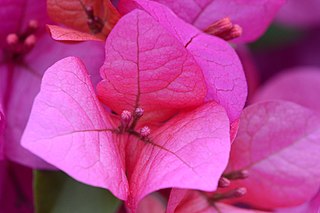
Bougainvillea is a genus of thorny ornamental vines, bushes, and trees belonging to the four o' clock family, Nyctaginaceae. They are native to Brazil, Peru, and Argentina. There are between 4 and 22 species in the genus. The inflorescence consists of large colourful sepal-like bracts which surround three simple waxy flowers, gaining popularity for the plant as an ornamental. The plant is named after explorer Louis Antoine de Bougainville (1729-1811), after it was documented on one of his expeditions.
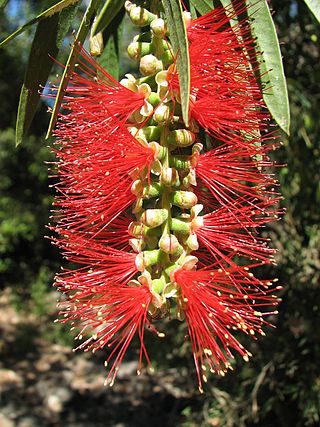
Callistemon is a genus of shrubs in the family Myrtaceae, first described as a genus in 1814. The entire genus is endemic to Australia but widely cultivated in many other regions and naturalised in scattered locations. Their status as a separate taxon is in doubt, some authorities accepting that the difference between callistemons and melaleucas is not sufficient for them to be grouped in a separate genus.

Telopea speciosissima, commonly known as the New South Wales waratah or simply waratah, is a large shrub in the plant family Proteaceae. It is endemic to New South Wales in Australia. No subspecies are recognised, but the closely related Telopea aspera was only recently classified as a separate species. T. speciosissima is a shrub to 3 or 4 m high and 2 m (6.6 ft) wide, with dark green leaves. Its several stems arise from a pronounced woody base known as a lignotuber. The species is well renowned for its striking large red springtime inflorescences (flowerheads), each including hundreds of individual flowers. These are visited by the eastern pygmy possum , birds such as honeyeaters (Meliphagidae), and various insects.
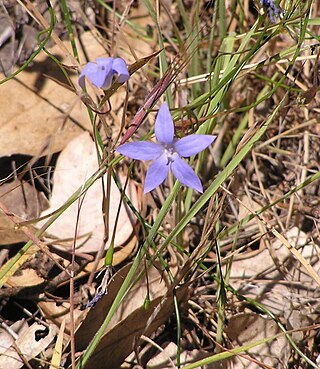
Wahlenbergia stricta, the Australian bluebell, tall bluebell or austral bluebell, is an Australian wildflower from the Campanulaceae family. It is considered the most commonly encountered of the Wahlenbergias. It is found in all Australian states but not the Northern Territory. It is often seen growing by the side of the road, enjoying the extra runoff.

Tasmannia lanceolata, commonly known as pepper tree, native pepper, mountain pepper or mountain pepperbush, is a species of flowering plant in the family Winteraceae, and is endemic to south-eastern Australia. It is a dioecious bushy shrub to small tree with lance-shaped or narrowly ellipic leaves, male and female flowers on separate plants, the flowers with 3 to 9 petals, and the fruit a deep maroon to glossy black berry.

Banksia ericifolia, the heath-leaved banksia, or lantern banksia, is a species of woody shrub of the family Proteaceae native to Australia. It grows in two separate regions of Central and Northern New South Wales east of the Great Dividing Range. Well known for its orange or red autumn inflorescences, which contrast with its green fine-leaved heath-like foliage, it is a medium to large shrub that can reach 6 m (20 ft) high and wide, though is usually half that size. In exposed heathlands and coastal areas, it is more often 1–2 m (3.3–6.6 ft).

Chamelaucium uncinatum, the Geraldton waxflower, Geraldton wax, is a flowering plant endemic to Western Australia. It is an erect shrub 0.5 to 4m high, bearing white or pink flowers June–November. The name uncinatum means "hooked" in Latin, in reference to the tips of the leaves.

Echinacea purpurea, the eastern purple coneflower, purple coneflower, hedgehog coneflower, or echinacea, is a North American species of flowering plant in the family Asteraceae. It is native to parts of eastern North America and present to some extent in the wild in much of the eastern, southeastern and midwestern United States as well as in the Canadian Province of Ontario. It is most common in the Ozarks and in the Mississippi/Ohio Valley. Its habitats include dry open woods, prairies and barrens.

Melaleuca viminalis, commonly known as weeping bottlebrush or creek bottlebrush, is a plant in the myrtle family Myrtaceae, and is endemic to New South Wales, Queensland and Western Australia. It is a multi-trunked, large shrub or tree with hard bark, often pendulous foliage and large numbers of bright red bottlebrush flowers in spring and summer. It is possibly the most commonly cultivated melaleuca in gardens and its cultivars are often grown in many countries.

Callistemon 'Splendens' is a commonly grown cultivar of the plant genus Callistemon. It has a compact and rounded habit and usually grows to about 2 metres high and wide, although it may grow taller. Large, well-displayed "brushes" are produced in late spring, with further flowering sometimes occurring at other times. New growth is pink-tinged and the leaves are elliptic and up to 90 mm long and 20 mm wide.

Acacia 'Scarlet Blaze' is a cultivar of Acacia leprosa originating from Victoria in Australia. It is noted for its unusual red flowers.
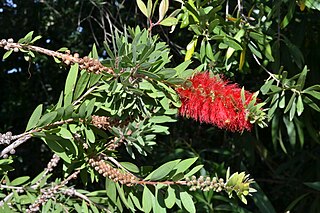
Melaleuca citrina, the common red bottlebrush, crimson bottlebrush, or lemon bottlebrush, is a plant in the myrtle family Myrtaceae, and is endemic to eastern Australia. Some Australian state herbaria continue to use the name Callistemon citrinus. It is a hardy and adaptable species, common in its natural habitat. It is widely cultivated, not only in Australia. It was one of the first Australian plants to be grown outside the country, having been taken to England in 1770 by Joseph Banks. Its showy red flower spikes, present over most of the year in an ideal situation, account for its popularity.

Sophora molloyi, the Cook Strait kōwhai, Molloy's kōwhai or Stephen's Island kōwhai, one of 8 species of kōwhai native to New Zealand, grows naturally around the Cook Strait region. It was first described as a species in 2001 and named after Brian Molloy of Landcare Research, who was a researcher and scientist for more than 30 years.

Erythranthe naiandina, the Chilean monkey flower, is a perennial species of flowering plant in the family Phrymaceae. It is native to Chile. This plant has been awarded the Award of Garden Merit by the Royal Horticultural Society. It was formerly known as Mimulus naiandinus.
References
- 1 2 3 "Would the real Callistemon 'Captain Cook' please stand up?". Australian Plants Online. Australian Native Plants Society (Australia). December 1998. Archived from the original on 30 October 2009. Retrieved 30 November 2009.
- 1 2 "Callistemon 'Captain Cook'". Australian Native Plants Society (Australia). Archived from the original on 19 September 2009. Retrieved 30 November 2009.
- 1 2 3 4 5 6 Seale, Allan (1988). Garden Companion to Australian Native Plants. Australia: Reed Books. ISBN 0730101878.